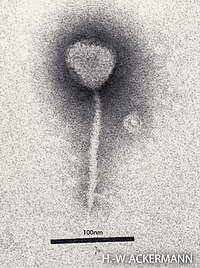
Photo from wikipedia
In this study, the trends of antimicrobial resistance in Neisseria gonorrhoeae were analysed in Shandong Province of China during 2007 to 2014. Furthermore, the ceftriaxone (CRO) genetic resistance determinants, including… Click to show full abstract
In this study, the trends of antimicrobial resistance in Neisseria gonorrhoeae were analysed in Shandong Province of China during 2007 to 2014. Furthermore, the ceftriaxone (CRO) genetic resistance determinants, including penA, mtrR, penB, ponA, and pilQ genes, were sequenced and the molecular mechanisms of decreased susceptibility or resistance to CRO in N. gonorrhoeae were elucidated. Overall, the increasing trends of resistance to penicillin (PEN), tetracycline (TET), and ciprofloxacin (CIP), and decreasing trends of susceptibility to CRO and azithromycin (AZM) were observed in Shandong Province between 2007 and 2014. The proportions of PPNG, TRNG, PP/TRNG, and MDR isolates increased sharply in this district. PenA mosaic structure, the substitution of A501V, and an insertion of aspartate in amino acid position 345 were identified in the N. gonorrhoeae isolates with decreased susceptibility or resistance to CRO. All the 28 N. gonorrhoeae isolates had substitutions at Gly-120 and Ala-121 of porin encoded by penB, substitution of L421P in PBP1, and a single nucleotide (A) deletion in the 13 bp inverted repeat located between the -10 and -35 sequences in the mtrR promoter. Additionally, 21 N.gonorrhoeae isolates had substitutions of A39T/G45D in MtrR, and three new substitutions of R44G, L47R, and/or H105F in MtrR were observed. Therefore, PenA mosaic structure in N. gonorrhoeae and the substitutions of Ala-501 in PBP2 may considerably increase CRO MICs. A close association between the genetic polymorphisms in mtrR, penB, and ponA and the development of decreased susceptibility to CRO might be confirmed.
Journal Title: International journal of antimicrobial agents
Year Published: 2018
Link to full text (if available)
Share on Social Media: Sign Up to like & get
recommendations!